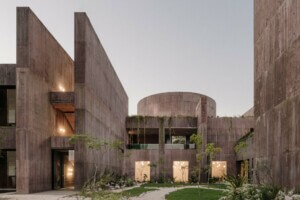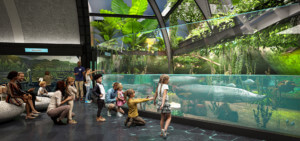| Brought to you by: |
California’s Monterey Bay Aquarium updates its million-gallon Open Sea exhibit
Located on the former site of a sardine cannery overlooking the Pacific, the Monterey Bay Aquarium pumps 2,000 gallons of seawater into its more than 100 exhibit tanks every minute. When its Outer Bay exhibit opened in 1996, it had the world’s largest single-pane window, measuring 56 feet long and 17 feet high. But turbulence created by the sea creatures inside unexpectedly damaged the aquarium’s liner, which flexed and loosened the grout that held its blue glass tiles in place. Large, fast-swimming tunas housed in the tank also caused damage by occasionally colliding with the lining. In 2010 the aquarium hired architectural composite consultant and fabricator Bill Kreysler, founder of Kreysler & Associates (K&A), to create a new Fiber Reinforced Polymer (FRP) liner for the exhibit, which recently reopened as the Open Sea galleries.
- Fabricator Kreysler & Associates
- Designer Kreysler & Associates
- Location Monterey, California
- Status Complete
- Materials Fiber Reinforced Polymer (FRP)
- Process 3-D modeling, CNC mold making, FRP casting, semi-aquatic installation
K&A began the project by researching new coatings that could improve the liner’s design. They found a gel-coat material called IMEDGE, which is designed to be abrasion-resistant and colorfast during long-term water immersion. In addition to being durable, the coating’s color would give the tank a more authentic deep-sea appearance. Testing done by an independent marine lab confirmed the material is nontoxic to marine life (and actually may have a positive impact on its health). The team also identified the impact forces exerted by the aquarium’s 250-pound tunas traveling at 25 knots and modeled the FRP liner’s structural characteristics accordingly.
Because the initial design phase had to be conducted while the tank was full, the team estimated measurements for their liner from the exterior. They planned to reuse the aquarium’s original FRP support ribs, but could not use their documented dimensions because of settling that would have occurred over their more than 15 years in the water. To account for the margin of error, the team designed the liner in 180 sections, most of which have unique curvatures. Adjacent pieces were designed to overlap, allowing the team to adjust them during installation.
Because pieces were designed and manufactured offsite, the aquarium’s downtime was limited to four months of installation, plus a few additional weeks to refill the tank and recondition the water. After inputting their 3-D models, K&A used a gantry-mounted CNC router to carve each section’s curves into large expanded polystyrene foam blocks, then built up layers of FRP over these molds to create a ¼-inch shell. Most of the liner’s sections measure approximately 10 by 12 feet.
The existing shell offered no place to attach building scaffolding, so installers worked from swing-stage scaffolding hanging from a concrete slab above. For their last time-saving trick, the team moved to floating platforms to finish the work, rising with the water level as the aquarium began to refill the tank—and prepare for a new wave of visitors.










